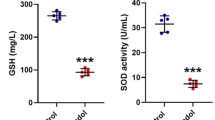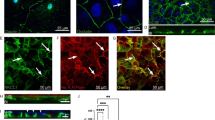Abstract
The choroid plexus (CP) participates in the synthesis, secretion and regulation of the cerebrospinal fluid, in the removal of its toxic compounds and in the regulation of the availability of essential metal ions to the brain. It expresses and secretes metallothioneins 1/2 (MT-1/2) which are key components in the maintenance of the central nervous system metal homeostasis and have anti-apoptotic properties, thereby protecting the brain. Glucocorticoids regulate MT-1/2 expression in several brain regions, but within the choroid plexuses (CPs) it remains unknown. Glucocorticoid levels increase in response to stress with implications in apoptosis. Further, CP expresses glucocorticoid (GR) and mineralocorticoid receptors (MR) turning it into likely glucocorticoid responsive structure. Data prompted us to study the regulation of MT-1/2 expression in response to glucocorticoids in the rat CP, and to investigate its implications in apoptosis. MT-1/2 protein and mRNA expression analysis showed that hydrocortisone up-regulates MT-1/2 expression in rat choroid plexus (RCP) cell line and in primary cultures of choroid plexus epithelial cells (CPEC) cultures via GR and MR. Also, incubation of RCP cells with hydrocortisone significantly diminished apoptosis, an effect eliminated by the addition of a MT-1/2 antibody. Moreover, induction of psychosocial stress, with concomitant rise of corticosterone levels, increased MT-1/2 expression in liver and in CP of male and female rats, with an exception observed in CP from males subjected to acute stress in which down-regulation in MT-1/2 expression occurred. Altogether, the results obtained demonstrated that stress/glucocorticoids regulate MT-1/2 expression in rat CP, with implications on apoptosis.






Similar content being viewed by others
References
Zheng W, Aschner M, Ghersi-Egea JF (2003) Brain barrier systems: a new frontier in metal neurotoxicological research. Toxicol Appl Pharmacol 192(1):1–11
Chodobski A, Szmydynger-Chodobska J (2001) Choroid plexus: target for polypeptides and site of their synthesis. Microsc Res Tech 52(1):65–82
Ghersi-Egea JF, Strazielle N (2001) Brain drug delivery, drug metabolism, and multidrug resistance at the choroid plexus. Microsc Res Tech 52(1):83–88
Crossgrove JS, Li GJ, Zheng W (2005) The choroid plexus removes beta-amyloid from brain cerebrospinal fluid. Exp Biol Med (Maywood) 230(10):771–776
Redzic ZB, Preston JE, Duncan JA, Chodobski A, Szmydynger-Chodobska J (2005) The choroid plexus-cerebrospinal fluid system: from development to aging. Curr Top Dev Biol 71:1–52
Santos CR, Martinho A, Quintela T, Gonçalves I (2012) Neuroprotective and neuroregenerative properties of metallothioneins. IUBMB Life 64(2):126–135
Ding ZC, Ni FY, Huang ZX (2010) Neuronal growth-inhibitory factor (metallothionein-3): structure–function relationships. FEBS J 277(14):2912–2920
Thirumoorthy N, Shyam Sunder A, Manisenthil Kumar K, Senthil Kumar M, Ganesh G, Chatterjee M (2011) A review of etallothionein isoforms and their role in pathophysiology. World J Surg Oncol 9:54
Stankovic RK, Chung RS, Penkowa M (2007) Metallothioneins I and II: neuroprotective significance during CNS pathology. Int J Biochem Cell Biol 39(3):484–489
Penkowa M (2006) Metallothioneins are multipurpose neuroprotectants during brain pathology. FEBS J 273(9):1857–1870
West AK, Hidalgo J, Eddins D, Levin ED, Aschner M (2008) Metallothionein in the central nervous system: roles in protection, regeneration and cognition. Neurotoxicology 29(3):489–503
Hidalgo J, Penkowa M, Giralt M, Carrasco J, Molinero A (2002) Metallothionein expression and oxidative stress in the brain. Methods Enzymol 348:238–249
Li GJ, Wei Z (2005) Regulation of neuroactive metals by the choroid plexus. In: Li GJ, Zheng W (eds) The blood–cerebrospinal fluid barrier. CRC Press, Boca Raton, pp 211–239
Vargas T, Ugalde C, Spuch C, Antequera D, Moran MJ, Martin MA, Ferrer I, Bermejo-Pareja F, Carro E (2010) Abeta accumulation in choroid plexus is associated with mitochondrial-induced apoptosis. Neurobiol Aging 31(9):1569–1581
Yokel RA (2006) Blood–brain barrier flux of aluminum, manganese, iron and other metals suspected to contribute to metal-induced neurodegeneration. J Alzheimers Dis 10(2–3):223–253
Karin M, Haslinger A, Holtgreve H, Richards RI, Krauter P, westphal HM, Beato M (1984) Characterization of DNA sequences through which cadmium and glucocorticoid hormones induce human metallothionein-IIA gene. Nature 308(5959):513–519
Hidalgo J, Belloso E, Hernandez J, Gasull T, Molinero A (1997) Role of glucocorticoids on rat brain metallothionein-I and -III response to stress. Stress 1(4):231–240
Hidalgo J, Campmany L, Marti O, Armario A (1991) Metallothionein-I induction by stress in specific brain areas. Neurochem Res 16(10):1145–1148
Hernandez J, Carrasco J, Belloso E, Giralt M, Bluethmann H, Kee Lee D, Andrews GK, Hidalgo J (2000) Metallothionein induction by restraint stress: role of glucocorticoids and IL-6. Cytokine 12(6):791–796
Gomez-Sanchez EP (2010) The mammalian mineralocorticoid receptor: tying down a promiscuous receptor. Exp Physiol 95(1):13–18
Sinclair AJ, Onyimba CU, Khosla P, Vijapurapu N, Tomlinson JW, Burdon MA, Stewart PM, Murray PI, Walker EA, Rauz S (2007) Corticosteroids, 11beta-hydroxysteroid dehydrogenase isozymes and the rabbit choroid plexus. J Neuroendocrinol 19(8):614–620
Sousa RJ, Tannery NH, Lafer EM (1989) In situ hybridization mapping of glucocorticoid receptor messenger ribonucleic acid in rat brain. Mol Endocrinol 3(3):481–494
Martinho A, Gonçalves I, Costa M, Santos CR (2012) Stress and glucocorticoids increase transthyretin expression in rat choroid plexus via mineralocorticoid and glucocorticoid receptors. J Mol Neurosci 48(1):1–13
Martinho A, Gonçalves I, Cardoso I, Almeida MR, Quintela T, Saraiva MJ, Santos CR (2010) Human metallothioneins 2 and 3 differentially affect amyloid-beta binding by transthyretin. FEBS J 277(16):3427–3436
Goncalves I, Quintela T, Baltazar G, Almeida MR, Saraiva MJ, Santos CR (2008) Transthyretin interacts with metallothionein 2. Biochemistry 47(8):2244–2251
Quintela T, Alves CH, Gonçalves I, Baltazar G, Saraiva MJ, Santos CR (2008) 5Alpha-dihydrotestosterone up-regulates transthyretin levels in mice and rat choroid plexus via an androgen receptor independent pathway. Brain Res 1229:18–26
Blazka ME, Nolan CV, Shaikh ZA (1988) Developmental and sex differences in cadmium distribution and metallothionein induction and localization. J Appl Toxicol 8(3):217–222
Sogawa N, Sogawa CA, Oda N, Fujioka T, Onodera K, Furuta H (2001) The effects of ovariectomy and female sex hormones on hepatic metallothionein-I gene expression after injection of cadmium chloride in mice. Pharmacol Res 44(1):53–57
Pfaffl MW (2001) A new mathematical model for relative quantification in real-time RT-PCR. Nucl Acid Res 29(9):e45
Herr I, Gassler N, Friess H, Buchler MW (2007) Regulation of differential pro- and anti-apoptotic signaling by glucocorticoids. Apoptosis 12(2):271–291
Schwerk C, Rybarczyk K, Essmann F, Seibt A, Molleken ML, Zeni P, Schroten H, Tenenbaum T (2010) TNFalpha induces choroid plexus epithelial cell barrier alterations by apoptotic and nonapoptotic mechanisms. J Biomed Biotechnol 2010:307231
Hidalgo J, Gasull T, Giralt M, Armario A (1994) Brain metallothionein in stress. Biol Signals 3(4):198–210
Brown PD, Kajita H, Majid A, Speake T (2000) Cl- channel expression in choroid plexus epithelial cells. J Korean Med Sci 15:S10–S11
Gunnar M, Quevedo K (2007) The neurobiology of stress and development. Annu Rev Psychol 58:145–173
Perez-Gracia E, Blanco R, Carmona M, Carro E, Ferrer I (2009) Oxidative stress damage and oxidative stress responses in the choroid plexus in Alzheimer’s disease. Acta Neuropathol 118(4):497–504
Jacob ST, Ghoshal K, Sheridan JF (1999) Induction of metallothionein by stress and its molecular mechanisms. Gene Expr 7(4–6):301–310
Ebadi M, Iversen PL, Hao R, Cerutis DR, Rojas P, Happe HK, Murrin LC, Pfeiffer RF (1995) Expression and regulation of brain metallothionein. Neurochem Int 27(1):1–22
Ebadi M, Pfeiffer RF, Huff A (1992) Differential stimulation of hepatic and brain metallothioneins by ethanol. Neurochem Int 21(4):555–562
Young EA, Altemus M, Parkison V, Shastry S (2001) Effects of estrogen antagonists and agonists on the ACTH response to restraint stress in female rats. Neuropsychopharmacology 25(6):881–891
Armario A, Hidalgo J, Bas J, Restrepo C, Dingman A, Garvey JS (1987) Age-dependent effects of acute and chronic intermittent stresses on serum metallothionein. Physiol Behav 39(2):277–279
Endres DB, Milholland RJ, Rosen F (1979) Sex differences in the concentrations of glucocorticoid receptors in rat liver and thymus. J Endocrinol 80(1):21–26
Turner BB (1986) Tissue differences in the up-regulation of glucocorticoid-binding proteins in the rat. Endocrinology 118(3):1211–1216
Csaba G, Inczefi-Gonda A (2001) Similarities and dissimilarities of newborn and adolescent rats in the binding capacity of thymic glucocorticoid receptors. Mech Ageing Dev 122(3):327–334
Herzog CJ, Czeh B, Corbach S, Wuttke W, Schulte-Herbruggen O, Hellweg R, Flugge G, Fuchs E (2009) Chronic social instability stress in female rats: a potential animal model for female depression. Neuroscience 159(3):982–992
Giacconi R, Cipriano C, Muzzioli M, Gasparini N, Orlando F, Mocchegiani E (2003) Interrelationships among brain, endocrine and immune response in ageing and successful ageing: role of metallothionein III isoform. Mech Ageing Dev 124(4):371–378
Mocchegiani E, Giacconi R, Cipriano C, Gasparini N, Orlando F, Stecconi R, Muzzioli M, Isani G, Carpene E (2002) Metallothioneins (I + II) and thyroid–thymus axis efficiency in old mice: role of corticosterone and zinc supply. Mech Ageing Dev 123(6):675–694
Munhoz CD, Garcia-Bueno B, Madrigal JL, Lepsch LB, Scavone C, Leza JC (2008) Stress-induced neuroinflammation: mechanisms and new pharmacological targets. Braz J Med Biol Res 41(12):1037–1046
Acknowledgments
The work was supported by a grant from Fundação para a Ciência e Tecnologia from Portugal, through a doctoral fellowship attributed to Martinho A. (SFRH/BD/32424/2006). The authors also like to thank to Dr. Filomena Silva, Dr. Vítor Gaspar and Dr Mafalda Fonseca for their expert assistance and helpful advices in flow cytometry experiments.
Author information
Authors and Affiliations
Corresponding author
Rights and permissions
About this article
Cite this article
Martinho, A., Gonçalves, I. & Santos, C.R. Glucocorticoids regulate metallothionein-1/2 expression in rat choroid plexus: effects on apoptosis. Mol Cell Biochem 376, 41–51 (2013). https://doi.org/10.1007/s11010-012-1547-9
Received:
Accepted:
Published:
Issue Date:
DOI: https://doi.org/10.1007/s11010-012-1547-9




